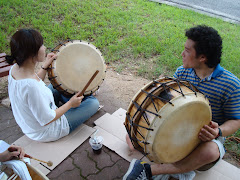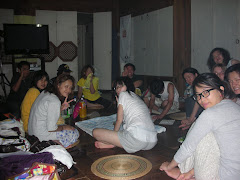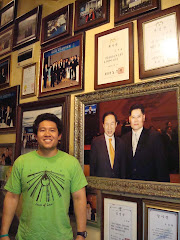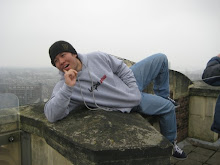On Tuesday I went on a two day trip to Gyeongju, the "world cultural heritage city rich in thousand-year-long history and tradition," which is located on the south-eastern side of the Korean peninsula. This area was originally part of the Silla state (57BC-995) during the Three Kindoms and Unified Silla periods, and thus is a rich source of these periods' histories and relics. I went with a tour group, which turned out to be very interesting. The other four people on the tour were students studying Korean at Han Yang University, and were all foreign students: one from Paraguay, one from Uruguay, one from Laos, and one from Guinea-Bissau. They were a very interesting bunch, and we ended up getting along really well.
It took about a good five hours to get to Gyeongju. We played hangman in the car to pass the time, and our Korean guide taught us how to play Korean hand games as well. Trying to teach Madilson, the student from Guinea-Bissau, how to play hangman was a trip. The long car ride proved to be well worth it. The first stop we made in Gyeongju was the Gyeongju National Museum. Many of the cultural artifacts from the Three Kingdoms period (57 BC-668) and reign of the Silla have been discovered in the surrounding areas and now preserved in this museum. One of my favorite things at the museum was the Divine Bell of King Seongdeok, one of Asia's largest and most resonant bells. It weighs nineteen tons and stands eleven feet high. If only I could've heard it ring...
Next we made our way to Anapji pond, which was a beautiful man-made pond and garden constructed by King Munmu in 674 to commemorate the unification of the Korean peninsula under Silla reign. Many of the relics now displayed in Gyeongju museum were actually discovered in this pond a few decades ago. Like the Silla royal family who spent their leisure time at this pond, I too savored the beauty and serenity of the place.
After walking around the pond, we went to see a collection of royal Silla tombs. There are over two hundred royal tombs scattered throughout Gyeongju alone, making Gyeongju somewhat like an outdoor museum. I was initially impressed by the massive size of the tombs, trying to imagine how they were built. While at first glance it seemed like there was no particular order in terms of how the tombs were arranged, our guide pointed out that the tombs were actually grouped together by family. I then noticed one tomb that actually looked like two tombs molded together. This was the joint tomb of the king and queen. How nice that they can be buried side by side! Right next to these tombs stood Cheomseongdae Observatory. Built during the reign of Silla Queen Seondeok, it is the oldest astronomical observatory in East Asia and has one stone slab for every day in the lunar year.
That night, I was lucky enough to stay in a comfortable hotel overlooking the placid Bomunho Lake. We woke up the next morning bright and early and made our way first to Seokguram Grotto, a sacred place for Buddhist worship and an enduring treasure of the Silla Kingdom. Right below Seokguram is Bulguksa Temple, which we visited afterwards. Enveloped in the mist and fog of the mountains, I could see how it would be easy to clear one's mind here. But would one have to scale the mountain every day for worship? As we were weaving our way up the mountain, we were overtaken by a monk driving an SUV. I guess that's one way to do it.
The last stop we made in Gyeongju was the Gyeongju Folkcraft Village. Here, craftsmen continue to preserve the old arts of making pottery and ceramics as was done during the Silla period. Celadon was the main material used, and we were lucky enough to see a craftsman skillfully fashion a pot using cattle skin and his bare hands. It was very fascinating seeing this ancient Silla art being preserved in this sort of remote location.
I was very fortunate to have this opportunity to go to Gyeongju, and to really see and feel Korea's past preserved so timelessly in this quiet city. Obviously there is more to Korea than what you just get in Seoul. And through this two-day excursion, I saw Korean essence through a different lens.






















































































































No comments:
Post a Comment